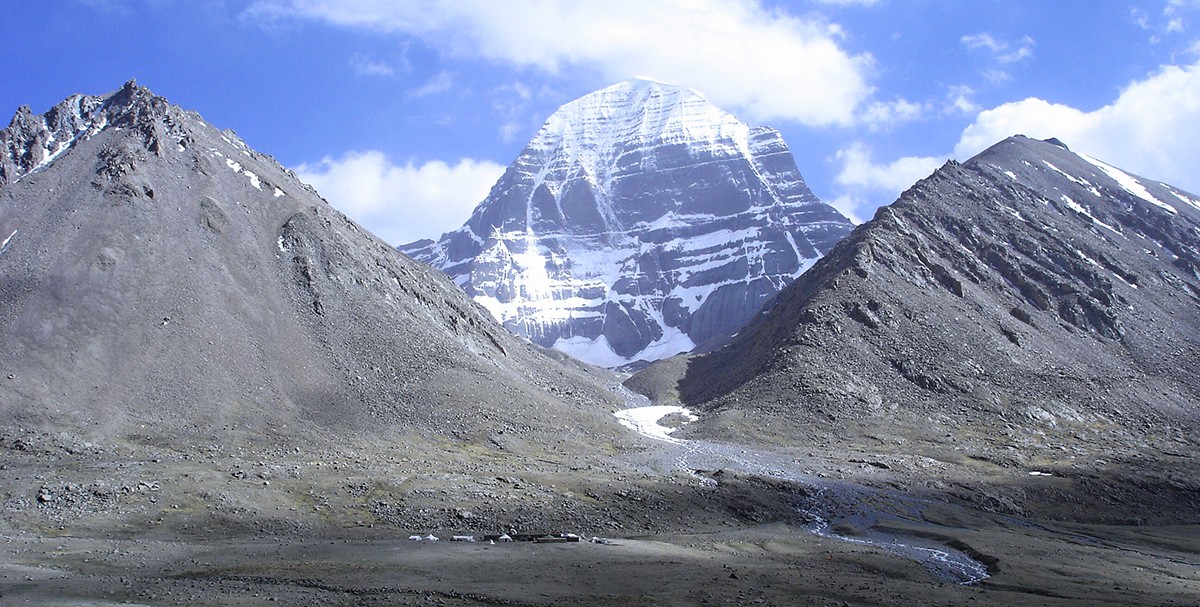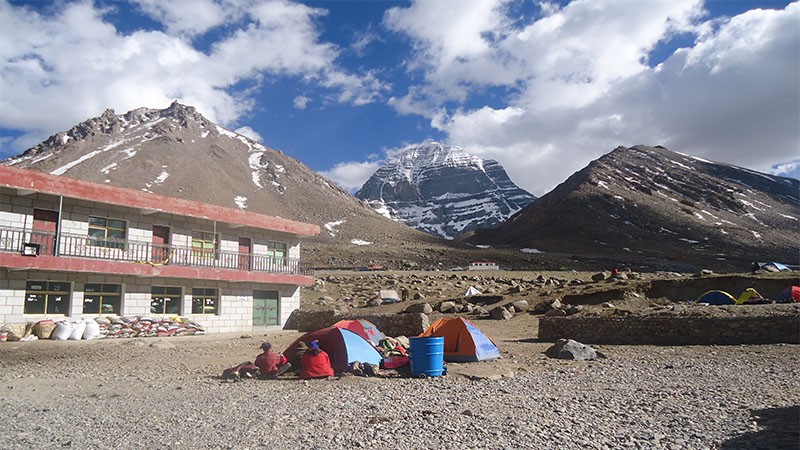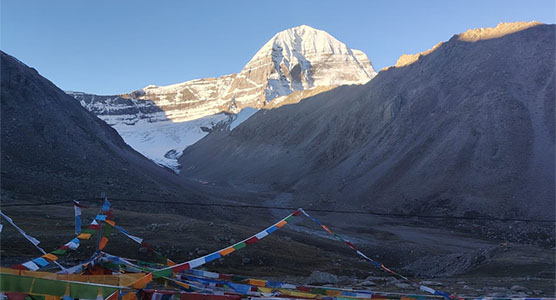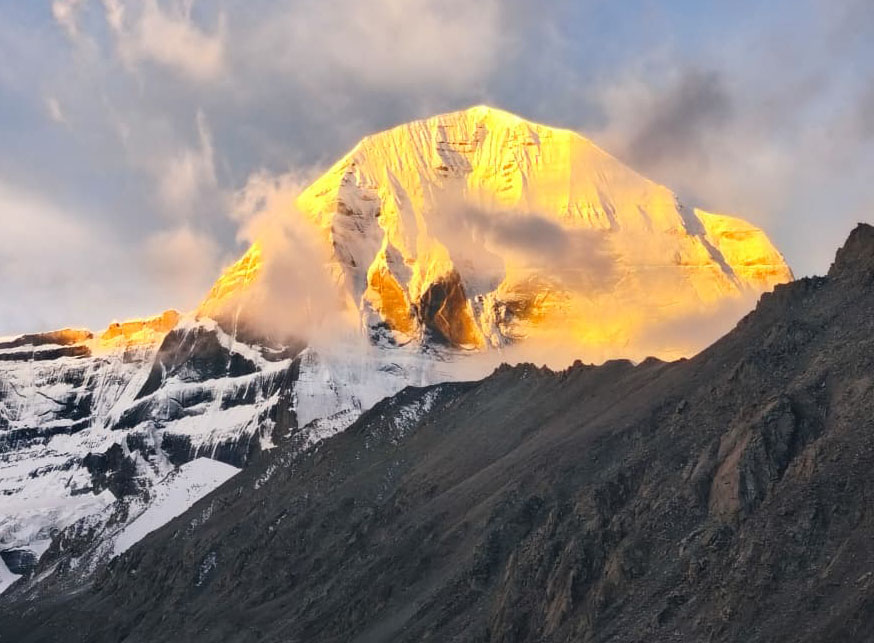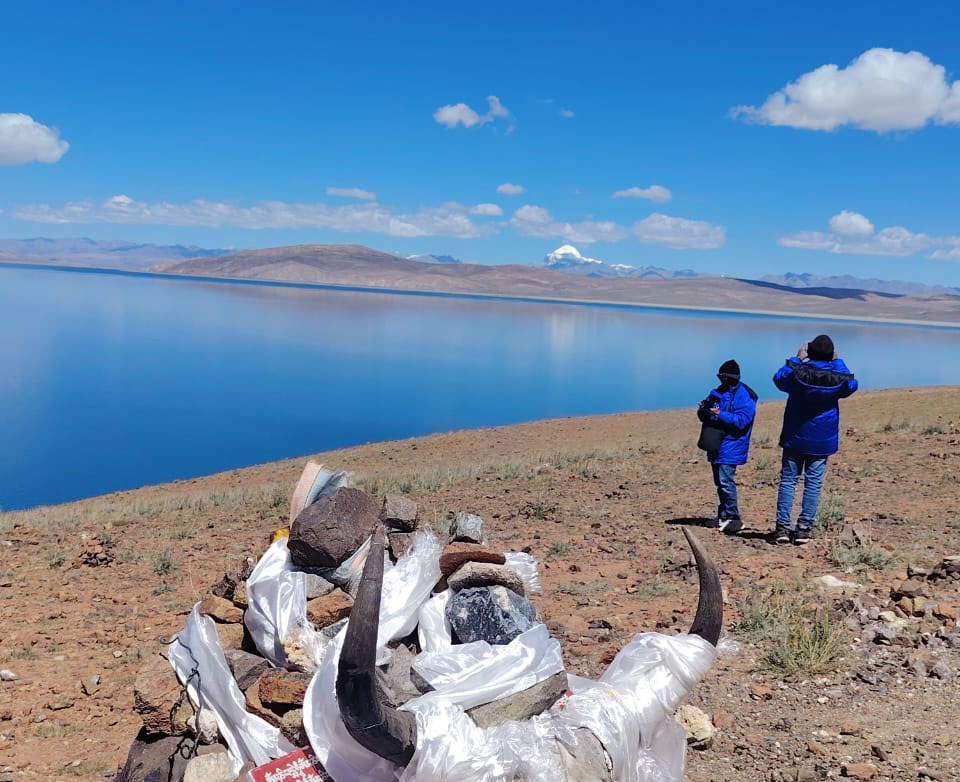Experience the most auspicious pilgrimage to Mount Kailash and Lake Mansarovar with full spiritual and logistical support. Join the once-in-12-year Kailash Mansarovar Yatra in 2026, the sacred Horse Year.
The year 2026 is of unparalleled significance to spiritual travelers worldwide, it is the Horse Year of the Tibetan cycle, a sacred cycle that occurs just once in 12 years. According to ancient custom, to make the Kora (circumambulation) of Mount Kailash in this year is twelve times more spiritually meritorious than an ordinary pilgrimage. It is the most auspicious time for Hindus, Buddhists, Jains, and Bon practitioners to make the sacred pilgrimage to Kailash Mansarovar alike.
Rising toweringly to 6,638 meters, Mount Kailash is a cosmic axis of the universe, the abode of Lord Shiva for Hindus, the place of enlightenment for Buddhists, Mount Ashtapada of the Jain faiths, and a spiritual citadel in the Bon religion. Along with the holy Lake Mansarovar, this is a place that has been a magnet for pilgrims for millennia, drawing seekers from everywhere on the planet seeking inner as well as outer change.
The Kailash Mansarovar Yatra 2026 is more than a pilgrimage; it is an experience of a lifetime to tread on a way where spirituality, belief, and nature find their most pristine forms. Journey leaves behind, with each step of the Kora, layers of earthly attachment and immerses themselves in the silence of the mountains and the richness of spiritual rebirth.
While the Horse Year strengthens the favors of this sacred path, pilgrims in the year 2026 will not only witness the splendour of the Himalayas but also take part in rituals on the peaceful shores of Lake Mansarovar, meditate in the shadow of Kailash, and experience an intense divine relationship.
This package is designed to enrich your pilgrimage spiritually and logistically, addressing the physical challenge of high-altitude trekking with professional guidance, immersion in local culture, and spiritual satisfaction. For you, who have long dreamed of standing at the feet of the mighty Mount Kailash, 2026 is the year of fulfillment.
Highlights of the Kailash Mansarovar Yatra:
- Perform the Kailash Kora in 2026, which is believed to be twelve times more spiritually beneficial than in any other year.
- Complete the 52 km Kailash Kora, a popular and significant gesture of devotion shared by Hindu, Buddhist, Jain, and Bon followers.
- Participate in bathing and meditation at Lake Mansarovar, symbolizing the purification.
- Travel across high-altitude desert, snow-capped peaks, and traditional valleys of Western Tibet.
- Witness the holy monasteries, Tibetan rituals, and the vibrant multicolored prayer flags along the pilgrim route.
- Cross the highest Kora point, Dolma La Pass (5,630 m), the cycle of birth and spiritual liberation.
- Be a part of a pilgrimage uniting followers of Lord Shiva, Buddhists, Jain Tirthankaras, and the believers of Bon.
- Travel with experienced leaders offering safety, acclimatization, and cultural understanding on the divine trek.
Major Highlights of Kailash Mansarovar Yatra 2026.
The Sacred Horse Year (2026)
The Kailash Mansarovar Yatra during the Horse Year (as per the Tibetan calendar) is said to be the best year to undertake this sacred pilgrimage. The Horse Year occurs every 12 years, and according to legend, this year Lord Shiva himself gives blessings to all the pilgrims undertaking the pilgrimage.
Spiritual literature and oral tradition emphasize that in the Horse Year, the religious merit of circumambulating the Kailash Kora is multiplied twelve times. One of the circumambulations in 2026 will be as good as twelve Koras taken in any other year. A dip in Lake Mansarovar this year will also purify one's lifetime of karma.
This makes the 2026 Yatra a very special opportunity; pilgrims of all faiths, from the farthest reaches of the world, want to participate in this lifetime journey. The aura around Mount Kailash and Lake Mansarovar becomes even more charged with spirituality, devotion, and blessings, and 2026 becomes not just a pilgrimage but a truly historic spiritual gathering.
Lake Mansarovar (4,590 m)
Lake Mansarovar is often considered to be the spiritual center of the Yatra. Located at an altitude of 4,590 meters, the huge freshwater lake stretches to 88 kilometers in circumference and is highly revered in Hinduism, Buddhism, Jainism, and Bon religions. It is said in Hindu mythology that Mansarovar was visualized by Lord Brahma himself in his mind before it was formed on earth, and for this reason, it was named "Manas" (mind) and "Sarovar" (lake).
A holy dip in Mansarovar Lake is believed to cleanse lifetimes of sin and lead one into spiritual liberation (moksha). Tradition has it that the lake itself changes hue throughout the day, becoming dark blue in the morning and golden hues at sunset, symbolizing the heavenly process of life, purity, and infinity. Pilgrims circumambulate the lake (parikrama), pray along the shores of the lake, and drink its clean water, which is attributed to be nectar. In 2026, during the Horse Year, bathing at Mansarovar is said to have 1,000 times more merit, so this experience becomes even more phenomenal.
Lake Rakshastal (The Lake of Demons)
Located directly opposite Mansarovar is Rakshas Tal, or Ravan Tal, and the Lake of Demons. Whereas Mansarovar symbolizes purity and divine awareness, Rakshas Tal represents worldly desires, ego, and delusion. In Hindu tradition, Ravana, the king of demons, performed intense penance on the shores of Rakshas Tal in a bid to gain boons from Lord Shiva.
In contrast to Mansarovar's pure, life-enriching waters, Rakshas Tal is saltwater, lifeless, and barren, the sole saline lake at this altitude. The contrast between these two lakes, clean and unclean, divine and hellish, represents the perpetual balance of good and evil forces in the cosmos. Pilgrims on the Yatra go to Rakshas Tal to consider the internal struggle between higher and lower impulses within themselves, and so it is a place of profound self-knowledge.
Mount Kailash Parikrama: The 3-day spiritual Kora around the Kailash Parbat.
Standing majestically tall at 6,638 meters, Mount Kailash is revered as the cosmic axis, the universe's center. For the Hindus, it is Lord Shiva's abode, where he sits in continuous meditation with Goddess Parvati. For the Buddhists, it is Mount Meru, the universe's central peak. Jains regard it as Mount Ashtapada, the place where their first Tirthankara attained enlightenment. In Bon, it is the seat of spiritual power.
The Kailash Parikrama or Kora is the most religious section of the Yatra and is completed by pilgrims of all faiths. The 52 km circuit of Mount Kailash is completed in three days traditionally, with each day having immense spiritual significance.
Kora Day 1: Darchen to Dirapuk (Approx. 14 km, 6–7 hours)
The Parikrama begins at Darchen, the base trekking town for Kailash. Pilgrims walk through the Valley of the Gods in breathtaking scenery. The night halt is at Dirapuk Monastery, which has one of the most marvelous views of the north face of Mount Kailash. Sleeping here is a sacred privilege as pilgrims spend the night in the shadow of the holy peak.
Kora Day 2: Dirapuk to Zuthulpuk via Dolma La Pass (Approx. 20 km, 8–9 hours)
The second day is the most difficult yet spiritually most rewarding. The trail climbs steeply to the Dolma La Pass (5,630 m), which marks death, liberation, and rebirth. Pilgrims traditionally leave some personal items here to symbolize the shedding of previous sins and karmic obstacles. Having crossed Dolma La, the descent leads past Gaurikunda, a tiny turquoise lake of great religious significance. You will stay at Zuthulpuk Monastery, which is associated with the great yogi Milarepa.
Kora Day 3: Zuthulpuk to Darchen (Approx. 12 km, 3–4 hours)
The final day of the Kailash Parikrama is easy, strolling on flat terrain along the river valley. Pilgrims return to Darchen and finish the sacred circuit. The completion of the Kora is believed to cleanse lifetimes of sin, and in the Horse Year, twelve times the merit of this 3-day Parikrama.
Dolma La Pass (5,630 m)
The highest and most challenging but spiritually rewarding part of the Kailash Kora is the Dolma La Pass at 5,630 meters. It has been so named after the beneficent goddess Dolma (Tara in Buddhism). The high-altitude pass symbolizes the cycle of birth and death. The ascent to Dolma La is not merely steep but physically and spiritually taxing, testing both physical strength and spiritual devotion. Pilgrims discard older clothes, personal belongings, or symbolic gifts at the top to represent the abandonment of past karma, sins, and worldly attachments. The descent back down the other side is representative of rebirth and renewal, being reborn into a new spiritual reality unencumbered by burdens.
Crossing Dolma La in the Horse Year is especially powerful. Pilgrims believe that the goddess Tara sends blessings to those who are crossing, multiplying the merit and helping them overcome cycles of pain. This makes Dolma La a physical trial as well as a profound spiritual initiation.
The Sacred Lake Gaurikunda.
Hidden on the trail of the Dolma La Pass, Gaurikunda is a glacial lake of dazzling beauty and mythological importance. As per Hindu mythology, Goddess Parvati bathed here, and the lake derives its sacredness and purity from her. Pilgrims typically stop at Gaurikunda to offer a prayer, take some holy water, or just meditate since it's believed that the goddess's blessings flow through its waters. The serene atmosphere of the lake in the middle of tough mountains makes it a divine moment of respite in the middle of the tough climb to Dolma La. For many, the sight of Gaurikunda is a spiritual experience in itself, reaffirming the Yatra's deep symbolic connection with purification, devotion, and divine grace.
Tirthapuri: The Sacred Abode of Vishnu and Bhasmasur.
Located to the west of Mount Kailash, Tirthapuri is a less-frequented but profoundly sacred site, traditionally linked to Hindu mythology. Myth says that Lord Vishnu slew the demon Bhasmasur, who had received the boon of turning anyone to ashes by a touch. Tirthapuri is sacred today for its hot springs, where pilgrims bathe to cleanse themselves after completing the arduous Kailash Kora. The site has Buddhist significance as well, with the monasteries and meditation caves adding to its sanctity. For the pilgrims, Tirthapuri represents purification and rebirth, a halt to cast off worldly fatigue, reflect on the journey, and prepare spiritually to receive the blessings of Mount Kailash and Lake Mansarovar.
Best Time to Go to Kailash Mansarovar Yatra
May to September is the ideal time to perform the Kailash Mansarovar Yatra, as the Tibetan plateau would have opened after winter, and the weather will be relatively stable. During this time, the weather improves and the skies clear, the weather is pleasant relative to winter's chill, and the high mountain passes like Dolma La become passable.
Of these, September, June, and May are the best months of the year, with good trekking conditions and good color of the surroundings, with minimal chance of heavy rain or snowfall. July and August, though hot, experience unpredictable monsoon rains, especially on the Nepal side.
Since 2026 is the Holy Horse Year, pilgrims should book in advance as thousands of pilgrims and tourists will be thronging Mount Kailash and Lake Mansarovar during this blue moon time. Reserving the Yatra within the best weather window not only ensures a more secure journey but also enhances the spiritual journey, allowing trekkers to complete parikrama, ritual bath, and meditation with ease and convenience.
The best time to plan a trip to Kailash Parikharama is:
> During the Saga Dawa time.
> Full moon of May
> Full moon of Jun.
> Full moon of July.
>Full moon of August.
> Full moon of September.
2026-Year of the Horse, Special year of Kailash Parikrama.
2026 is the Year of the Horse. Completing a Circle around Mount Kailash (known as Kora) once during this year is considered karmically equivalent to completing twelve Koras, making it the most sacred year for this pilgrimage. The Year of the Horse occurs once every twelve years, attracting thousands of pilgrims who will undertake the Mt. Kailash yatra to pay their respects.
Kailash Mansarovar Parikrama 16 Days itinerary;
Day 01: Arrive in Kathmandu (1350m), receive at the airport, and transfer to the hotel. Stay overnight at the Kathmandu hotel.
Day 02: After breakfast, Guided tour to Pasupatinath Temple, Guheshwori Shaktipeeth, and Budanilkantha Temple, stay overnight at KTM.
Day 03: After breakfast, guided tour of Kathmandu Durbar Square, Swayambhunath Temple, and Boudhanath Stupa. Stay overnight at a hotel in Kathmandu.
Day 04: Drive from Kathmandu to Rasuwa-Gadhi, 140 km, approximately 6-7 hours, and stay overnight in Rasuwa-Gadhi.
Day 05: Cross the Nepal-Tibet Friendship Bridge, clear immigration formalities, and drive to Kerung (Gyirong) (25 km in 40 minutes).
Day 06: Drive from Kerung (Gyirong) to Saga (4-5 hours, 4640m), 177 kilometers.
Day 07: Drive from Saga to Lake Manasarovar (8-9 hours, 890km, 4558m).
Day 08: Drive to Darchen (1 hour, 40km, 4575m).
Day 09: Drive from Darchen to Yamadwar, starting point of Kailash Kora (Parikrama) to Drerapuk (5 -6 hours, 4900m), approximately 14 Kilometers.
Day 10: Continue to Kailash Kora (Parikrama) to Zutrulpuk via Dolma La Pass 5640 meters (8-9 hours, 20km, 4760m).
Day 11: End the Kailash Kora and drive to Tirthpuri, 4310 meters (65 kilometers)
Day 12: Tirthpuri to Saga 555 kilometers (9-10 hours)
Day 13: Drive to Kerung (Gyirong), 177 kilometers, stay overnight at Kerung (Gyirong) about 4-5hours.
Day 14: Kerung (Gyirung) Kathmandu 165 kilometers, about 6-7 hours stay overnight at Hotel Kathmandu.
Day 15: Contingency day / Free day at Kathmandu.
Day 16: Departure.
FAQs About Kailash Mansarovar Yatra.
Why is the year 2026 special for the Kailash Yatra?
The Horse Year occurs every 12 years in the Tibetan calendar, and circumambulating Kailash at this time is considered very good fortune. Spiritual texts and practices claim that walking the Kora in the Horse Year gains twelve times the merit of a normal year. Travelers from all Hindu, Buddhist, Jain, and Bon traditions go out of their way to take their trek in 2026 to benefit from spiritual blessings in profusion.
When is the best time to do the Kailash Mansarovar Yatra?
The best time is May to September, the best months for trekking being May, June, and September. It provides clear weather, open high passes such as Dolma La, and convenient travel conditions. The pilgrims should not undertake the journey in cold winter months.
Can I do the full Mount Kailash Kora during the Kailash Mansarovar Tour?
Yes. The Kora is 52 km around Mount Kailash and typically takes 3 days to accomplish. It is believed to bring enormous spiritual merit, equivalent to completing several Koras in a non-Horse Year. Pilgrims typically combine it with Lake Mansarovar for maximum spiritual benefit.
How physically demanding is the Kailash Mansarovar Yatra?
The hike is challenging to moderate, requiring good endurance and basic trekking experience. Pilgrims will need to tolerate weather conditions at high altitudes, harsh landscapes, and multi-day hikes.
Is it possible to blend the Kailash Yatra with Lhasa or Tibetan cultural tours?
Yes. Pilgrims tend to include Lhasa, monasteries, and other sacred sites in Tibet on their tour. This lends cultural and historical value to the pilgrimage without neglecting completing Mount Kailash Kora and the pilgrimage to Lake Mansarovar.


